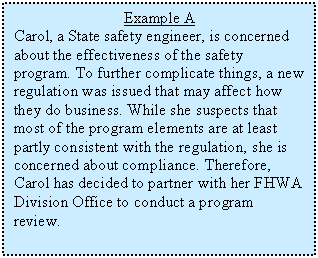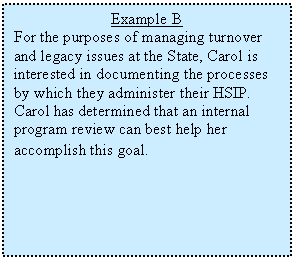U.S. Department of Transportation
Federal Highway Administration
1200 New Jersey Avenue, SE
Washington, DC 20590
202-366-4000
| < Previous | Table of Contents | Next > |
In general, a program review is a thorough analysis of key program components and the processes employed by the agency in managing the program. The reviews are conducted to 1) ensure compliance with Federal requirements; 2) identify opportunities for greater efficiencies and improvements to the program; and/or 3) identify exemplary practices. They can be referred to, or are known as, program improvement reviews, program assessments, program/product evaluations, or continuous process improvement initiatives. ¹
A program review is an effective means to conduct a periodic evaluation of the overall HSIP, a particular element of the HSIP (i.e., SHSP, State HSIP, HRRRP, RHXP) or to focus on a process within the HSIP (i.e., planning, implementation, evaluation). Sample program review topics are included in the Appendix.
The Data portion of this assessment tool will focus on how data is utilized to support the various programs under the HSIP. An assessment of a State’s crash data can be accomplished through FHWA’s Crash Data Improvement Program (CDIP). In addition, an assessment of your State’s entire traffic records system can be achieved through a Traffic Records Assessment sponsored by the National Highway Traffic Safety Administration.
The targeted area for a program review is often identified through the Division Office’s risk assessment process, in consultation with the SDOT, based on the stewardship agreement. Safety specialists might consider using a self assessment tool, such as the Program Delivery Improvement Tool (as described in the previous section), to feed the risk assessment process. The PDIT activity statements can be useful tools to gauge the overall “temperature” of the HSIP. A program review may be warranted if the discussion surrounding a particular activity statement indicates:
The following are examples of questions that a HSIP Program Review may help to answer:
The examples provided below further illustrate scenarios for which a HSIP program review may be beneficial.


FHWA has identified oversight of Federal-aid projects administered by local public agencies (LPA) as an agency risk. This aspect of the HSIP will likely be part of LPA or financial management reviews.
Typical steps for conducting a program review are as follows:
The Work Zone Process Review Toolbox outlines the Steps for a Review (as noted above) in the “ABCs” of Process Reviews” and provides additional explanatory details for each step of the program review process. While there are references to work zone process reviews throughout the document, the steps are generic enough to apply to all program areas, including the HSIP. Follow-up and monitoring are essential to the success of program reviews. Follow-up and monitoring may be in the form of regularly scheduled status meetings (i.e., quarterly, biannual) or presentations at appropriate meetings of task forces, managerial groups, etc.
Program review training entitled “Conducting Effective Program Reviews” is available through the National Highway Institute. The workshop provides training and hands on assistance in the methodology and tools available for conducting successful reviews.
A sample set of questions is included in the Appendix. These questions can be used to support the information gathering process (as identified in Step 2 and obtained in Step 3 of the review process), whether in the format of an interview or a questionnaire. These questions can be used as a starting point; however, they should be modified to address the intent of the program review and the target audience. They are organized by program area (General, SHSP, State HSIP, HRRRP, RHXP) and within each program by process (i.e., planning, implementation, evaluation). Examples of additional information resources that can support the review process are included in the Appendix.
Many Divisions have conducted HSIP-related program reviews, some of which are available in the Resource Center’s Program Review Library [available to FHWA personnel only]. It may be beneficial to review some of the HSIP-related program review reports to get a feel for what has been done in other States. In many instances, the report outlines the process used to conduct the review as well, which could prove useful in planning your review. The Program Review Library also contains a program review report template and writing and style guide that can be used to document your review efforts.
The FHWA Office of Safety conducted a National Review of HSIP. While the National Review predates SAFETEA-LU, many of the noteworthy practices identified are still relevant. Noteworthy practices, whether identified as part of the National Review or an HSIP-related peer review, can be used as the basis for the recommendations set forth in Step 5 of the review process. If a State is interested in further exploring how another State does business in a particular area, it may be beneficial to host an HSIP-related peer review (as described in the next section).
¹ Federal Aid Highway Program Stewardship/Oversight Agreement Guidance, April 14, 2006: http://staffnet.fhwa.dot.gov/programadmin/041406.doc
| < Previous | Table of Contents | Next > |
